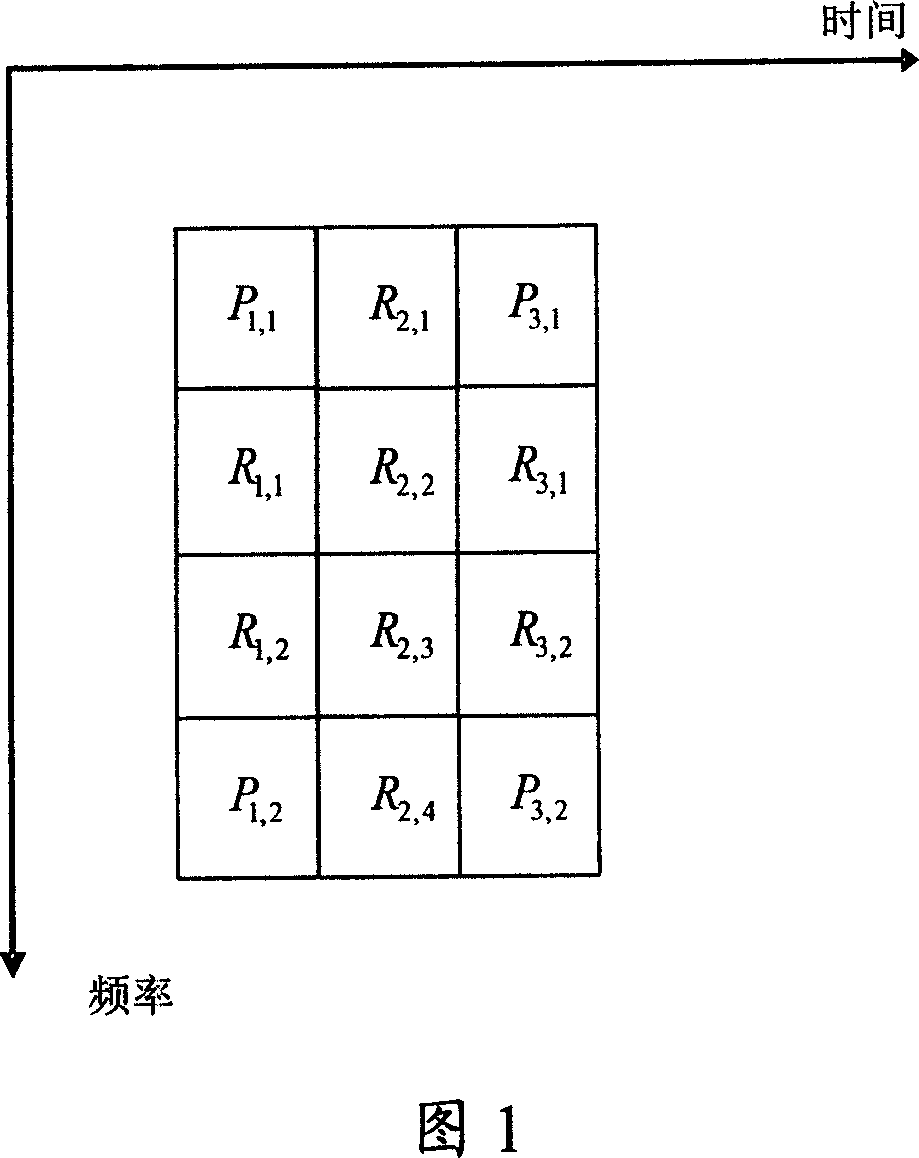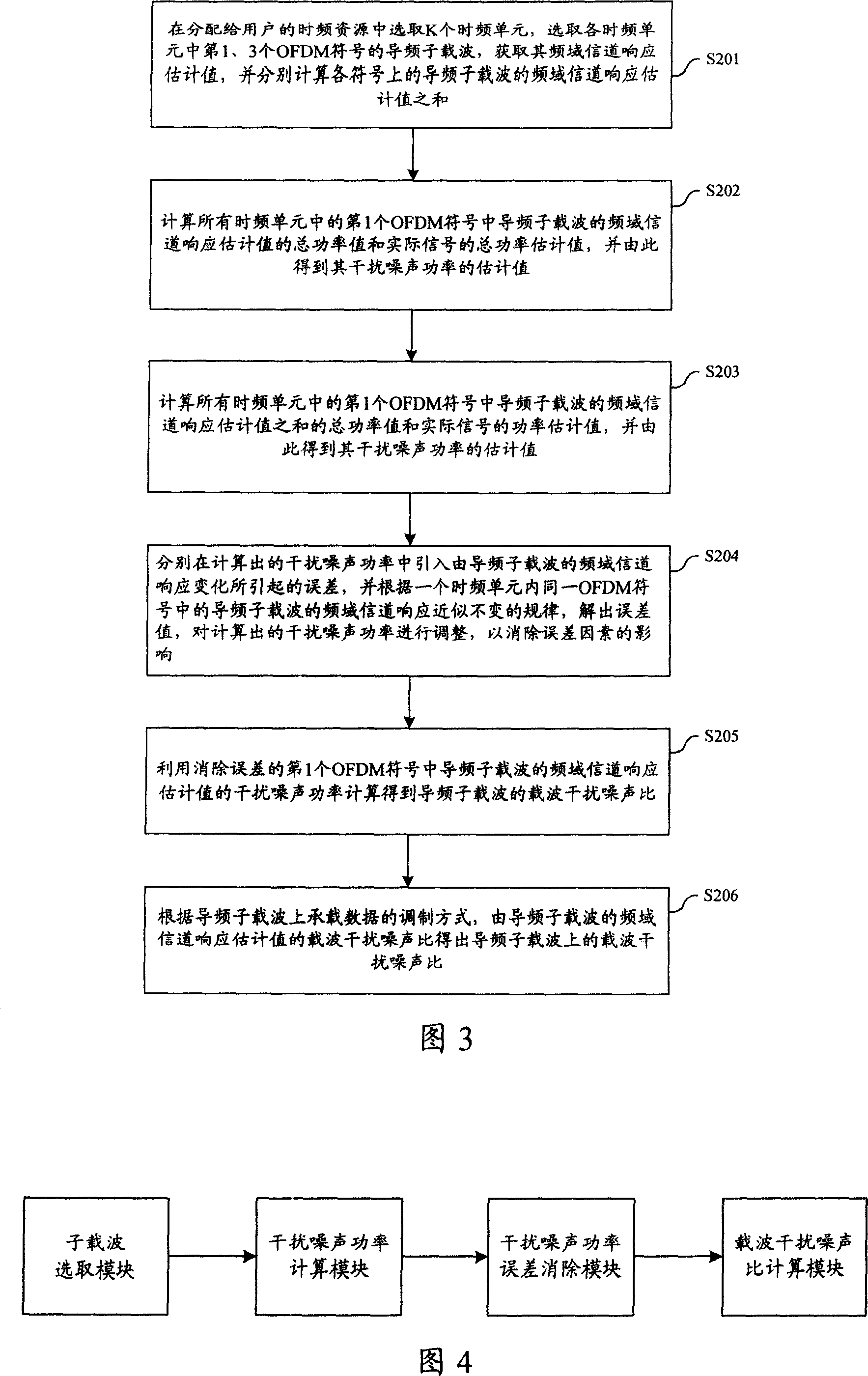Method and device of measuring carrier interference noise ratio
A technology of carrier interference and interference noise, applied in the direction of multi-frequency code system, etc., can solve the problem of inaccurate measurement of carrier-to-interference-noise ratio, and achieve the effects of overcoming inaccurate measurement, improving flexibility, and improving adaptability
- Summary
- Abstract
- Description
- Claims
- Application Information
AI Technical Summary
Problems solved by technology
Method used
Image
Examples
Embodiment 1
[0099] This embodiment describes the specific process of measuring the carrier-to-interference-noise ratio of the sub-carrier by using the estimated value of the channel response in the frequency domain on the pilot sub-carrier in the 802.16e uplink PUSC mode.
[0100] This embodiment follows the examples cited in the prior art. The prior art has proved that when the modulation mode of the pilot subcarrier carrying data is BPSK, the pilot subcarrier P i,j,k (i=1 or 3, 1≤j ≤2, 1≤k≤K) carrier-to-interference-noise ratio and its frequency-domain channel estimation value (i=1 or 3, 1≤j≤2, 1≤k≤K) have the same carrier-to-interference-to-noise ratio, therefore, the carrier-to-interference-to-noise ratio of the pilot subcarriers can be measured by frequency domain channel estimation.
[0101] Referring to FIG. 2 , it is a schematic flow chart of measuring the carrier-to-interference-noise ratio by using the frequency-domain response signal estimation value of the pilot subcarrier in...
Embodiment 2
[0170] This embodiment describes the specific process of measuring the carrier-to-interference-noise ratio of the sub-carrier by using the estimated value of the channel response in the frequency domain on the pilot sub-carrier in the 802.16e uplink PUSC mode. The process is similar to the first embodiment, except that the implementation Example 1 is to measure the carrier-to-interference-noise ratio through the carrier-to-interference noise power of two OFDM symbols. In this embodiment, the carrier-to-interference-noise ratio is measured through the carrier-to-interference noise power of one OFDM symbol.
[0171] Referring to Fig. 3, for the present invention utilizes the frequency domain channel response estimated value of pilot subcarrier to measure the flow diagram of carrier-to-interference-noise ratio under 802.16e system uplink PUSC mode, its specific steps include:
[0172] S201. Select K time-frequency units in the time-frequency region allocated to the user, and selec...
Embodiment 3
[0252] This embodiment describes the specific process of measuring the carrier-to-interference-noise ratio of the sub-carrier by using the estimated value of the channel response in the frequency domain on the data sub-carrier in the 802.16e uplink PUSC mode.
[0253] Figure 1, R i,j Represents a data subcarrier, i is the number of an OFDM symbol in a time-frequency unit, and j is the number of a data subcarrier in the same OFDM symbol in a time-frequency unit. Suppose an uplink data resource block contains K time-frequency units, R i,j,k Represents the j th data subcarrier of the i th OFDM symbol in the k th time-frequency unit. This embodiment utilizes the data subcarrier R i,j,k (i=1, 3; 1≤j≤2, 1≤k≤K) Carrier interference noise measurement, the specific steps include:
[0254] S301. Select K time-frequency units in the time-frequency region allocated to the user, and select the data subcarrier R in the first and third OFDM symbols in each time-frequency unit i,j,k (i=1,...
PUM
 Login to View More
Login to View More Abstract
Description
Claims
Application Information
 Login to View More
Login to View More - R&D
- Intellectual Property
- Life Sciences
- Materials
- Tech Scout
- Unparalleled Data Quality
- Higher Quality Content
- 60% Fewer Hallucinations
Browse by: Latest US Patents, China's latest patents, Technical Efficacy Thesaurus, Application Domain, Technology Topic, Popular Technical Reports.
© 2025 PatSnap. All rights reserved.Legal|Privacy policy|Modern Slavery Act Transparency Statement|Sitemap|About US| Contact US: help@patsnap.com



